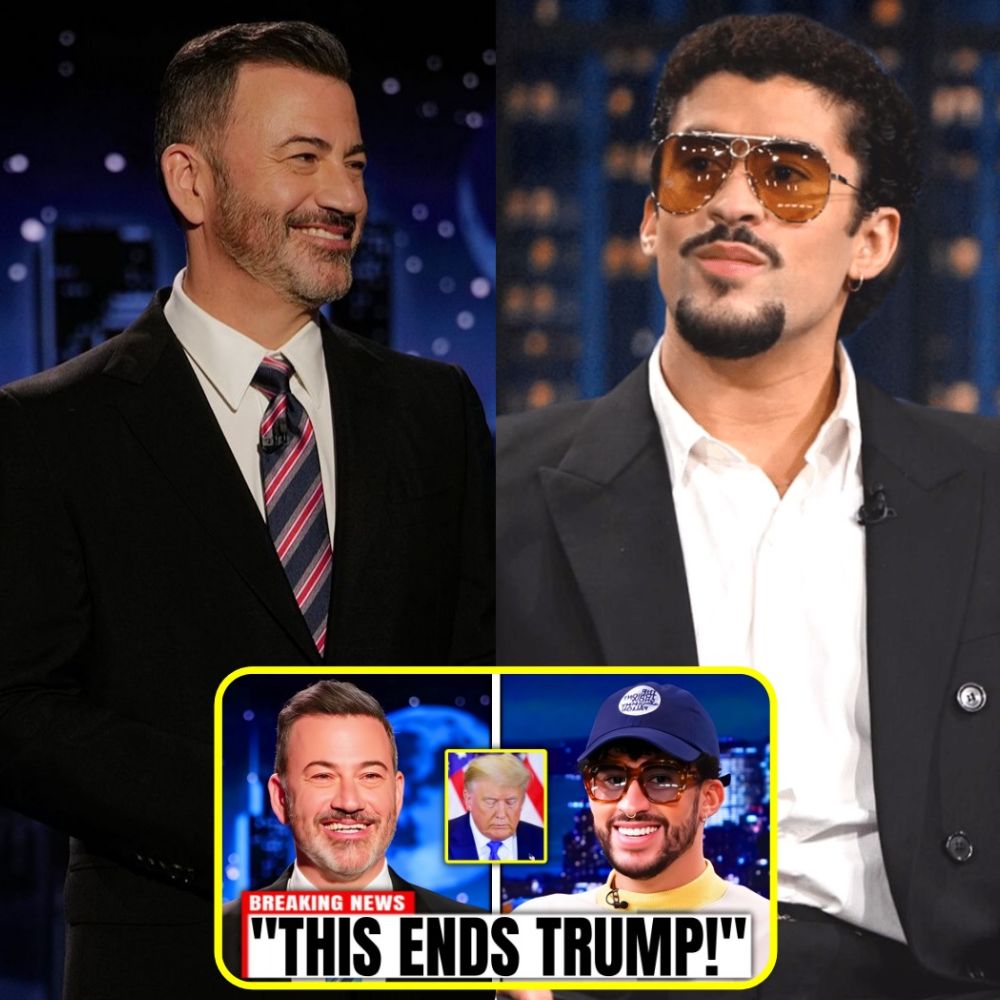Jimmy Kimmel and Bad Bunny SHOCK America — Expose Trump LIVE on Air

In a dazzling display of comedic and cultural force, Jimmy Kimmel and Bad Bunny joined together on live television to deliver one of the most memorable takedowns of former President Donald Trump in recent memory. The segment, now trending across social media, was not just a roast—it was a multi-layered critique of modern American politics, media spectacle, and the power of art to outshine outdated authority.
Kimmel opened the segment with his signature blend of dry wit and biting satire, describing America as being in the “strong, capable, darkly bruised baby hands of the orangutan in the Oval Office.” He lampooned Trump’s obsession with spectacle, referencing the president’s scheduled checkup at Walter Reed Hospital—his second in a year—mocking the White House’s tendency to release absurdly exaggerated health statistics.
Kimmel’s jokes painted Trump’s administration as a badly written sitcom, full of recycled plot twists, cheap dialogue, and a lead character who refuses to leave the stage. “Every week is a new episode. Every scandal, a plot twist recycled from last season,” Kimmel quipped, likening press briefings to filler episodes where the cast improvises because the script didn’t arrive on time.
Bad Bunny, the global Puerto Rican superstar, brought a different kind of energy to the segment. He didn’t argue with Trump—he simply outlived him. His very presence on stage, confident and unshaken by approval, was a living rebuttal to Trump’s politics of exclusion. Bad Bunny’s art, music, and image embody plurality and celebration, everything Trump pretends doesn’t exist.
“His existence is the rebuttal,” Kimmel observed. “His very image, a Puerto Rican superstar commanding global attention while Trump preaches division becomes satire made flesh.” Bad Bunny’s performances are not just entertainment—they are cultural revolutions disguised as concerts, messages of unity in the face of division.
Together, Kimmel and Bad Bunny transformed Trump’s tantrums into comedy gold, but the humor was more than mockery—it was a form of prophecy. Kimmel described Trump as a man auditioning endlessly for applause he can’t hear anymore, a leader allergic to fact-checking, baffled that the world won’t bend to his script. The administration, he said, is “a traveling circus missing its tent. Just noise, performers, and a lion that keeps tweeting.”
The jokes landed not because they were exaggerated, but because the reality they described was already absurd. Kimmel’s satire was understated, letting Trump’s own actions supply the diagnosis. “We didn’t elect a leader. We hired a headliner,” he mused, as the segment’s laughter shifted from mockery to disbelief.
While Trump tried to control the narrative, Bad Bunny responded with silence and art. He didn’t need to reply to insults—he released music. His concerts became declarations that belonging isn’t granted by borders, but by belief. Bad Bunny’s success exposed the hollowness of Trump’s culture war: “You can’t fight the future with nostalgia.”
The segment also touched on serious issues, including the ongoing battle over the release of the Epstein files. Kimmel noted the political maneuvering in Congress and the refusal to swear in a Democrat who could tip the balance toward transparency. The satire here was sharp, exposing how spectacle and self-interest have replaced genuine governance.
As the segment drew to a close, Kimmel and Bad Bunny’s message became clear: noise isn’t power, and attention isn’t respect. The spectacle of Trump’s presidency, once loud and dominating, was quietly dissolving beneath the weight of its own absurdity. When the lights dimmed, what remained was not applause, but awareness—a quiet, brutal message that a leader built on spectacle cannot survive the stillness of truth.
In that final moment, Kimmel and Bad Bunny didn’t just destroy Trump—they unmasked him. The laughter stopped, the rhythm ended, and reality reclaimed its stage.
This viral segment was more than entertainment—it was a cultural reckoning. Kimmel’s humor and Bad Bunny’s artistry combined to expose the emptiness of spectacle-driven leadership and to celebrate the resilience of culture, unity, and truth. In a nation exhausted by division and drama, their performance offered not just laughs, but a glimpse of hope for a future where art leads and absurdity fades.